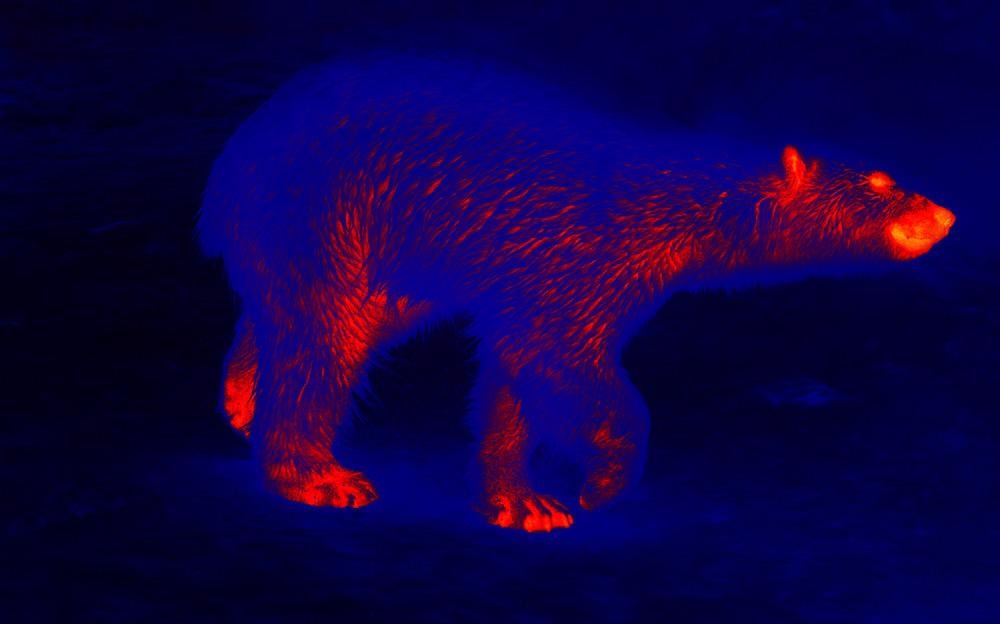Thermal imaging technology has dramatically reduced in cost since the mid-2000s, enabling its use in a wide variety of settings. A critical area that cheaper thermal imaging has impacted is wildlife conservation. Here, it can enable wide-reaching, impactful surveys and ongoing, passive monitoring at a fraction of the cost of other methods.

Image Credit: Maximillian cabinet/Shutterstock.com
Thermal imaging is a powerful remote sensing technique with several applications in various fields. In animal ecology field studies, thermal imaging is an entirely passive, non-intrusive technique that works day and night, and in many weather conditions.
Image data can be collected in real-time from various camera platforms: stationary hides, land-based roving robots, underwater, helicopters, and drones.
Thermal imaging, which records light in the infrared (IR) wavelength, improves visible imaging because it can ‘see through’ smoke, aerosols, dust, and mist effectively and works better in the dark. This means that animals can be detected over a wide area despite atmospheric conditions that may otherwise cause problems for imaging.
Thermal imaging is well-suited for wildlife monitoring and conservation applications as it minimizes the effects of disturbing animals while collecting survey data.
The Challenge of Wildlife Monitoring for Conservation
According to experts, human activities are accelerating species extinction rates by approximately 1,000 times over the background extinction rate.
The IUCN reports that 27,000 species are at risk of extinction worldwide and need to be placed under conservation measures to avoid total destruction.
This number may be higher as not every species was assessed in the IUCN report. In 2019, the UN estimated that one million species worldwide were on the brink of extinction after extrapolating the IUCN data to include all animal species.
The key to solving this problem is effective wildlife monitoring. We need to know more about wild animal populations worldwide, how they are changing over time, and where they are at risk.
Wildlife monitoring is a significant challenge. Animals at risk of extinction often live across vast territories, in remote, dangerous, or politically unstable areas, and are adept at avoiding prying eyes.
Conservationists need systems that can remotely, passively, and reliably identify animals living in or passing through a given area.
Remote, Passive, and Reliable Sensing: Thermal Imaging
Thermal imaging converts IR (infrared) radiation –heat – into visible images that show the distribution of temperature differences in a scene.
It is important to note that the technology does not compare temperatures to each other in the scene, but rather, they record the emissivity of an object against the backdrop. This makes them well-suited to record animals with warm blood against a cold background.
Thermographic cameras used for thermal imaging detect radiation in the long-infrared range of approximately 9 μm to 14 μm. The thermogram produced by these cameras is another name for a thermal image.
Thermographic cameras look similar to simple handheld camcorders. Sometimes, a standard camera will be built in to overlay thermal images on top of optical images. However, thermal imagery can include enough detail to be unnecessary in some applications.
In the last decade or so thermal imaging cameras using uncooled microbolometers as focal plane array (FPA) sensors have entered the market at a dramatically reduced cost. This has made thermal imaging more accessible for a much more comprehensive range of applications, including wildlife monitoring and conservation.
Using Thermal Imaging for Wildlife Conservation
Thermal imaging – owing to the latest generation of inexpensive, easy-to-use hardware – has quickly become an attractive monitoring method for ecologists worldwide. It works in all light levels, making it well-suited for monitoring cryptic, nocturnal, and crepuscular species without disturbing their natural behaviors.
The majority of ecological consultancy involving thermal imagery has been for monitoring bat species. However, it is also used for surveying birds and assessing whether mammals are using land before embarking on infrastructure projects.
New Opportunities for Wildlife Monitoring with Thermal Imaging
As inexpensive hardware is relatively new, thermal imaging still finds new use cases for wildlife monitoring today.
These developments combine advances in multiple fields to achieve wide-ranging, semi-automated wildlife monitoring. An example is drones or unmanned aerial vehicles (UAVs), with artificial intelligence and MEMS (miniaturized electromechanical system) technology to make flying thermal cameras that can survey large areas for a relatively low cost.
This system was presented by researchers in an article in the journal Sensors, which also included test results showing the thermal video data accurately detecting target wildlife in the surveyed area. This system is responsive to user input, meaning it is flexible enough to automatically film and identify different species.
Read more on thermal imaging and its use in space applications
References and Further Reading
Gonzalez, L.F., et al. (2016) Unmanned Aerial Vehicles (UAVs) and Artificial Intelligence Revolutionizing Wildlife Monitoring and Conservation. Sensors (Basel). doi.org/10.3390/s16010097.
Havens, K.J. and E.J. Sharp (2016) Thermal Imaging Techniques to Survey and Monitor Animals in the Wild: A Methodology. Academic Press. doi.org/10.1016/C2014-0-03312-6.
Pimm, S.L., et al. (2014) The biodiversity of species and their rates of extinction, distribution, and protection. Science. doi.org/10.1126/science.1246752.
UN (2019). UN Report: Nature’s Dangerous Decline ‘Unprecedented’; Species Extinction Rates ‘Accelerating.’ [Online] United Nations. Available at: https://www.un.org/sustainabledevelopment/blog/2019/05/nature-decline-unprecedented-report/ (Accessed on 20 April 2022).
Williams, K.F., (2019). Thermal imaging for wildlife surveys. [Online] Inside Ecology. Available at: https://insideecology.com/2018/06/05/thermal-imaging-for-wildlife-surveys/ (Accessed on 20 April 2022).
Disclaimer: The views expressed here are those of the author expressed in their private capacity and do not necessarily represent the views of AZoM.com Limited T/A AZoNetwork the owner and operator of this website. This disclaimer forms part of the Terms and conditions of use of this website.